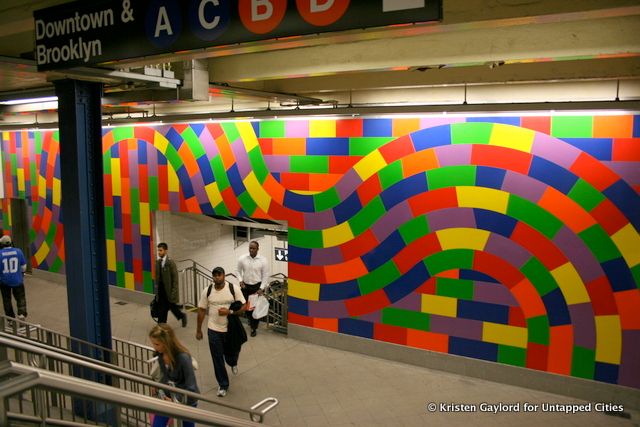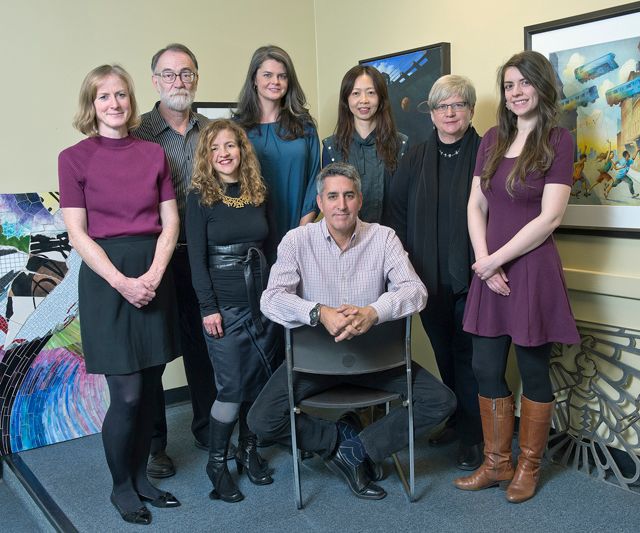10 Giant Menorahs That Will Light Up for Hanukkah in NYC
From Brooklyn to the Bronx, we’ve rounded up the most exciting giant menorahs that will light up throughout the next eight evenings!

 “Sky Reflector-Net” by James Carpenter, Grimshaw Architects and ARUP, is the largest single work ever commissioned by MTA Arts & Design.
“Sky Reflector-Net” by James Carpenter, Grimshaw Architects and ARUP, is the largest single work ever commissioned by MTA Arts & Design.
The New York City subway system is beaming with amazing art installations–from colorful mosaics to the “Sky Reflector-Net” at the recently opened Fulton Center, which also boasts a new digital arts program on 52 screens. Of course, the subway system today is worlds apart from the one in 1970s (remember the images of graffiti covered subway trains?). But over the years, one group within the MTA has made our ride more imaginative–MTA Arts & Design (formerly known as MTA Arts for Transit and Urban Design)–has slowly but steadily amassed an incredible underground Art Museum spanning across all five boroughs, pumping an artistic energy into the subway system.
As MTA Arts & Design approaches its 30th anniversary, Untapped Cities had the opportunity to talk with Sandra Bloodworth, who has been the director of MTA Arts & Design since 1996. Her latest book, New York’s Underground Art Museum: MTA Arts & Design has just been released. She graciously talked about various topics including the early days of the organization, opportunities and challenges that have evolved over the years and bringing public art into New York’s public transit. The interview was conducted by Catherine Mondkar and Bhushan Mondkar and will be presented in four parts in the coming weeks. We begin the series by talking about the origin and evolution of MTA Arts & Design.
Untapped Cities: Can you please tell us about the inception and early days of MTA’s Arts & Design?
Sandra Bloodworth: In the early 80s the MTA was a system on the brink of collapse. Trains were literally breaking down and it was not unusual to be stuck in a broken train. We were also looking at a system that was marred with graffiti. MTA leadership was very active in trying to come up with programming and financing to save the entire system. In the very beginning around 1985, the funding was really focused on infrastructure; need for new tracks and trains. When that got under control, a very industrious station rehabilitation program began which included designating a percentage of funds for permanent art in the stations. Prior to 1985, some of this was already happening through the Department of Cultural Affairs. However, Ronay Menschel, then a board member of the MTA (and former Deputy Mayor under Ed Koch,) had the insight to know that this rebuilding program would be massive and the arts management needed to happen internally as a part the MTA, in order to interact with these massive projects. That was a brilliant vision!
The MTA hired Wendy Feuer as the Founding Director, to incorporate the projects from the Department of Cultural Affairs into ‘Arts for Transit’ and also establishing a ‘percent for art’ program, where, you invest a percentage of funds in art, as part of the rebuilding process. Those early days were dedicated mostly to establishing this policy. To begin, we looked at the art we had and asked ourselves–what materials had held up over 80 years? Mosaics and tiles had held up. We have a very difficult subterranean environment and everywhere we looked, if man or nature had not intervened, these materials were in pristine condition. Also, we needed art that was not going to come with tremendous maintenance issues as there were miles and miles of walls. So we encouraged artists to consider using durable materials. We realized that the majority of the artists would not be familiar with our environment or working in mosaics. But throughout history, mosaicists have fabricated the work of artists, so why would we not do the same?
Artists who paint and draw were given a list of approved fabricators, to create their work. We set up all sorts of processes by which this would work for the artists, and it served them extremely well from the beginning. In doing that we opened up public art to all artists. We also led efforts to save the existing historic mosaics that we inherited while we worked to commission new works. The first art piece commissioned under Arts for Transit was “Open Secret” a series of bronze reliefs by Houston Conwill at 125th street.
In the early days, there were a lot of doubters who didn’t believe anything could hold up in our system, but very quickly they saw, just as others saw 80 years prior during the ‘City Beautiful’ movement, that creating great places of beauty would bring out the higher nature of the citizenry. We followed the same philosophy, that if we gave great respect to these transit spaces, so would our customers; and they have. It was a positive thing for the MTA to do and showed that the agency cared. You would walk into a 80-90 year old station, and then there would be this beautiful art! That was, I believe, the rebirth of the subway system including the LIRR and Metro North; it sent a big message to New Yorkers, visitors and investors–that if you could turn around New York’s subway system, you could turn around New York.
Untapped Cities: You have been with the MTA Arts & Design for 26 years, how has it evolved over the years, what are the different challenges you have encountered?
Sandra Bloodworth: When you’re commissioning art in an environment such as the NYC subway, there are many challenges and they have evolved over the years. The mission of the MTA is to create and enhance the journey, to transform the experience of transportation. We face challenges every day, but we also have a tremendous network of colleagues throughout the agency that help us approach those challenges.

Art in Transit! Sol LeWitt’s “Whirls and twirls,” at the 59th Street-Columbus Circle.
Just the concept of putting art into the transit environment is a challenge. What has changed in the past 25 years, is that initially a great deal of time was spent articulating internally why we must do this and justifying the benefits of art in the subway system. Today, I don’t have to tell New Yorkers (and haven’t for many years) why art is important; they know, they live in New York. And it is amazing to live in a city that understands how important art is to the economy and to the quality of life.
With the advent of technology you don’t have to justify how art transports you, (no pun intended) but it does–it transports you, it transforms you, it speaks to you and creates intimate moments in public places. That is a wonderful change–just knowing that people understand the importance of art. To be part of an agency in a city where people appreciate what our team is doing to bring art to the public, is incredible. It is also a social justice issue that the public deserves a good ride and good stations, from the Rockaways to the Bronx.
There are so many people across the agency that do not get much attention, who wake up every morning and make the best effort to provide New Yorkers with a good ride and a great experience. It’s wonderful to be part of that greater group of people in MTA. Every time there is a storm people love to find the street that didn’t get plowed. People love to find the things that don’t work. Close your eyes and go back 26 years to those images [of the collapsing subway system and trains marred with graffiti] and then to go into the system today and see what has been done to make this a great place. Can we do it better? You bet. We work every day to advocate for better design, and we try our best to provide design excellence within this environment to give our customers the very best.
MTA’s challenges are so real and incredible, look at the ravages of Super Storm Sandy, and we, at Arts & Design, still have an obligation to our customers that we give them a world class ride in this world class city. Our challenges are greater than any I know of, anywhere else I’ve been.
If you stop and focus on what has been accomplished, it is amazing, the system is amazing. You ask what is our challenge? It is the challenge of every employee of the MTA, to run and operate a system that is over a hundred years old in a dense urban environment. That is an incredible challenge. We run 24/7, we carry 5.5 million people through our system daily, (In September, a new record of 6.1 million was reached!) so while I appreciate the role of advocacy, I also think it’s time for people to get out and celebrate what has been accomplished.

At Arts& Design, we have an incredible team, and they have brought a fresh new vision. They are curating art for the future; for people who are being born today. I am a bridge, but this team is really the future of the Arts in the NYC subway. Randy Kennedy once said, “the subway system is the most underrated art museum in New York City,” and I believe, it is in very good hands.

The Team at MTA Arts & Design– L to R- Lydia Bradshaw, Rob Wilson, Katherine Meehan, Amy Hausmann, Lester Burg (Seated), Yaling Chen, Sandra Bloodworth, Kate Amato. Photo courtesy: Patrick Cashin for MTA.
Watch Sandra Bloodworth, tell the story of the amazing rebirth of the New York’s subway system over the past three decades and how the introduction of permanent art has transformed the transit experience in New York:
[youtube https://www.youtube.com/watch?v=tLEgCMpxmAg?rel=0&w=640&h=360]
To celebrate their upcoming 30th anniversary, MTA Arts & Design recently announced a new book: New York’s Underground Art Museum: MTA Arts & Design which is now available for sale. Written by Director Sandra Bloodworth and Bill Ayres and released by Monacelli Press, the book is an updated companion to Along the Way which was published in 2006. The new edition includes nearly 100 new works of art that have been commissioned and installed over the past eight years.
Check out our top 10 favorite art installations in the NYC subwa and read the next installation of this interview series with Sandra Bloodworth.
Get in touch with the Authors at @bhushan_NYC and @catherine2m
Subscribe to our newsletter